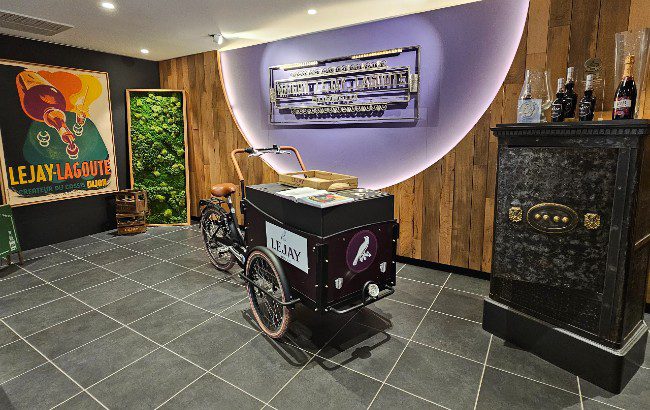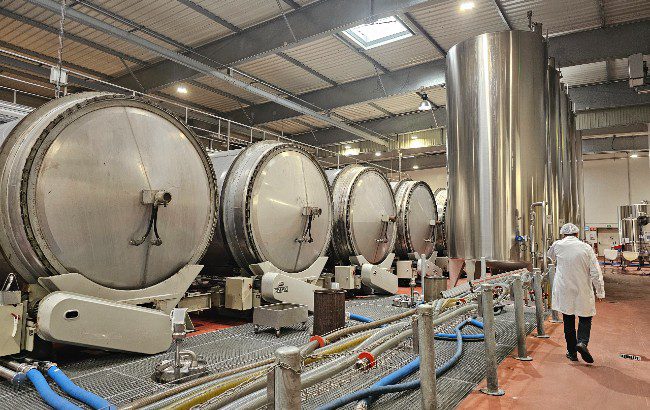SB visits… Lejay Lagoute, Dijon
Dijon might be closely associated with mustard, but there is a rich history of liqueurs in this French town, as SB discovered during a recent visit.

For more than 180 years, Maison Lejay Lagoute has been a leader in the crème de cassis category. This French blackcurrant liqueur is frequently reached for to add sweet, tart blackberry notes to cocktails – and is arguably best known for its role in the classic Kir Royale serve.
Maison Lejay Lagoute founder Auguste-Denis Lagoute was the first liqueur maker in Dijon in 1841. His son-in-law, Henri Lejay, was credited with helping to grow awareness of crème de cassis throughout France, and internationally – hence the company name. The heritage of the company is apparent from the moment you set foot on the production site. The entrance to the factory is encased with the original gate from the original factory all these years later.
While Dijon is the certified home of crème de cassis de Dijon, there are three areas in France where cassis is produced: Burgundy (50%), Pays de la Loire (40%) and Val d’Oise (10%). Maison Lejay Lagoute, owned by La Martiniquaise-Bardinet, is the world’s leading buyer of cassis. Lejay Original is the flagship cassis from the brand, crafted from Blackdown blackcurrant varietal. The resulting profile offers rich blackcurrant aromas, with red fruit jam, ripe cherry and dark chocolate. With its velvety texture, the palate brings heaps of blackcurrant flavour throughout the tasting experience.
Then, there is Lejay Noir de Bourgogne, named after the second blackcurrant varietal used by the producer – Noir de Bourgogne. The result is a richer, more intense aromatic profile, with earthy and delicate wood notes. The velvet texture on the palate remains, with added complexity from dark chocolate and black cherry.

The duo was recently joined by a third expression: Bitter Cassis, the first new liqueur from the brand in almost a decade. The new edition uses the distillery’s blend of Noir de Bourgogne and Blackdown blackberries and buds, which are macerated in eaux-de-vie. The bitter flavour is achieved by addition of citrus fruits and orange peel, and was specifically designed for bartenders seeking alternative, innovative bitter products.
Olivier Melis, director at Lejay Lagoute, said: “Bitter Cassis is more for mixing, maybe with tonic water, ginger beer, in cocktails – particularly classic serves like the Negroni. We wanted our own bitter with our own story.”
Production begins in the fields. Once the blackcurrants have been harvested, they are transported to the production site where each varietal is macerated individually in 70% ABV alcohol made from beetroot. “We use beetroot neutral grain spirit because we don’t want flavours of sugarcane or other raw materials. Beetroot gives a more neutral flavour for us to work with,” Melis explained. Berries to be used at a later date are frozen to ensure the same quality of maceration all year long.

Over six to eight weeks, sometimes up to 10 weeks if necessary, the maceration tank is lightly stirred, before the valve is opened to collect the first juice, aided only by gravity and Lejay’s production team. “Every two to three days we take samples to check the development,” Melis noted. “We are testing the physical chemical content, but also the organoleptic profile.”
When it comes to blending the crème de cassis, this can take anywhere from one to four hours depending on the recipe. Granulated sugar is added for sweetness and according to the legal requisites for liqueur production along with a unique ingredient to Maison Lejay Lagoute – the infusion of blackcurrant buds, which offer a vegetal note.
The bottling process is also done on site, an operation that spans 1,500 square metres. A trio of bottling lines have the capability of bottling between 3,500 and 8,000 bottles per hour. Annually, that equates to a maximum production output of up to 12 million bottles.
“Our bottling lines cater for both the main Lejay design, and alternative designs,” Melis said. “Certain markets, like Japan, are very particular about the design and strict quality standards we must adhere to, so we have particular production runs to meet these requirements from the market.”
The brand is confident in its trio of blackcurrant-flavoured offerings – and is seeing demand grow on an international level. Melis is excited about the brand’s potential. “We have a very good portfolio. We have very strong ties to the bar industry. I think we are on the right path to keep growing and to continue this success,” he said. “I’m very excited about our future.”

Related news
Is cassis the new star of the summer?
